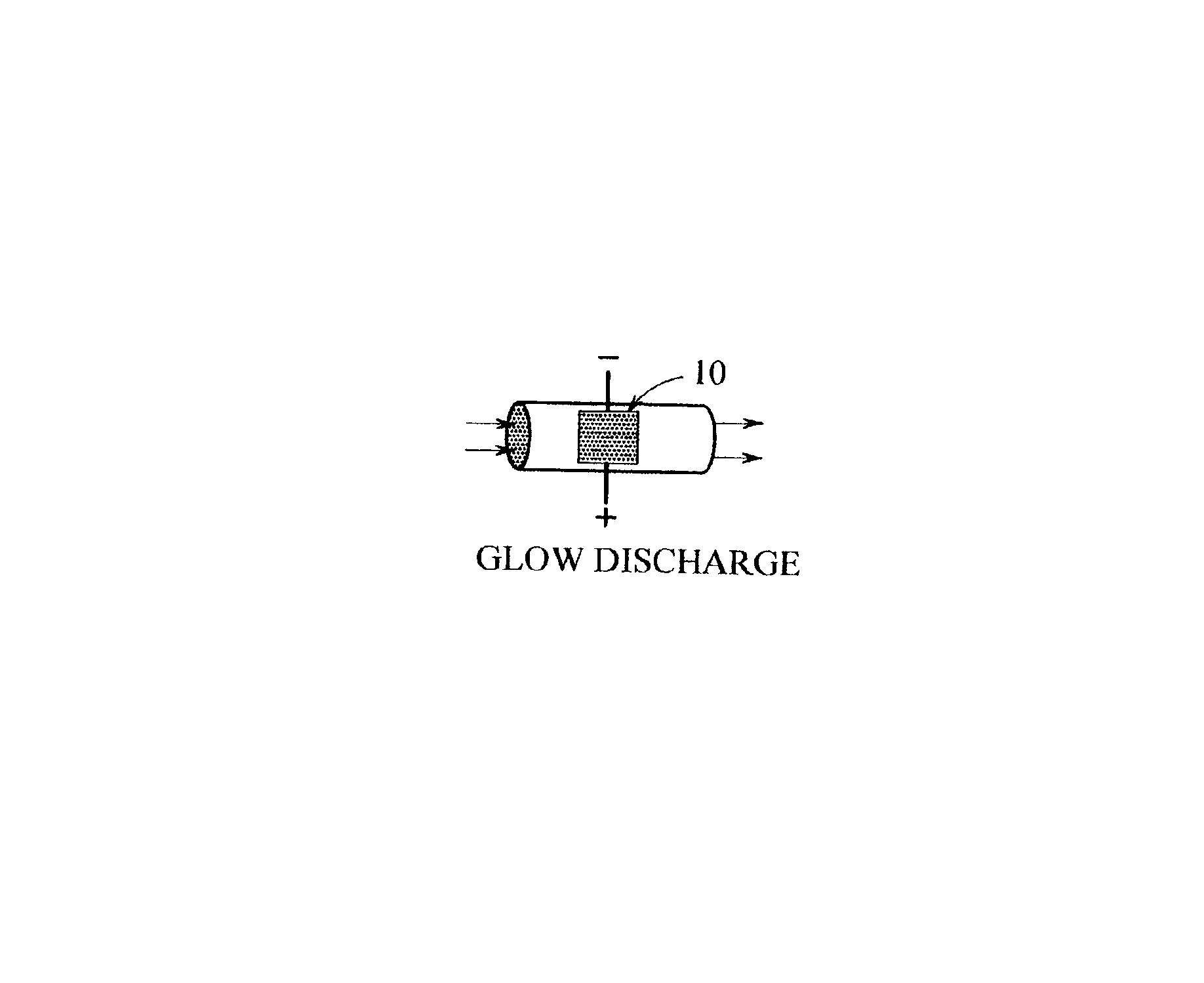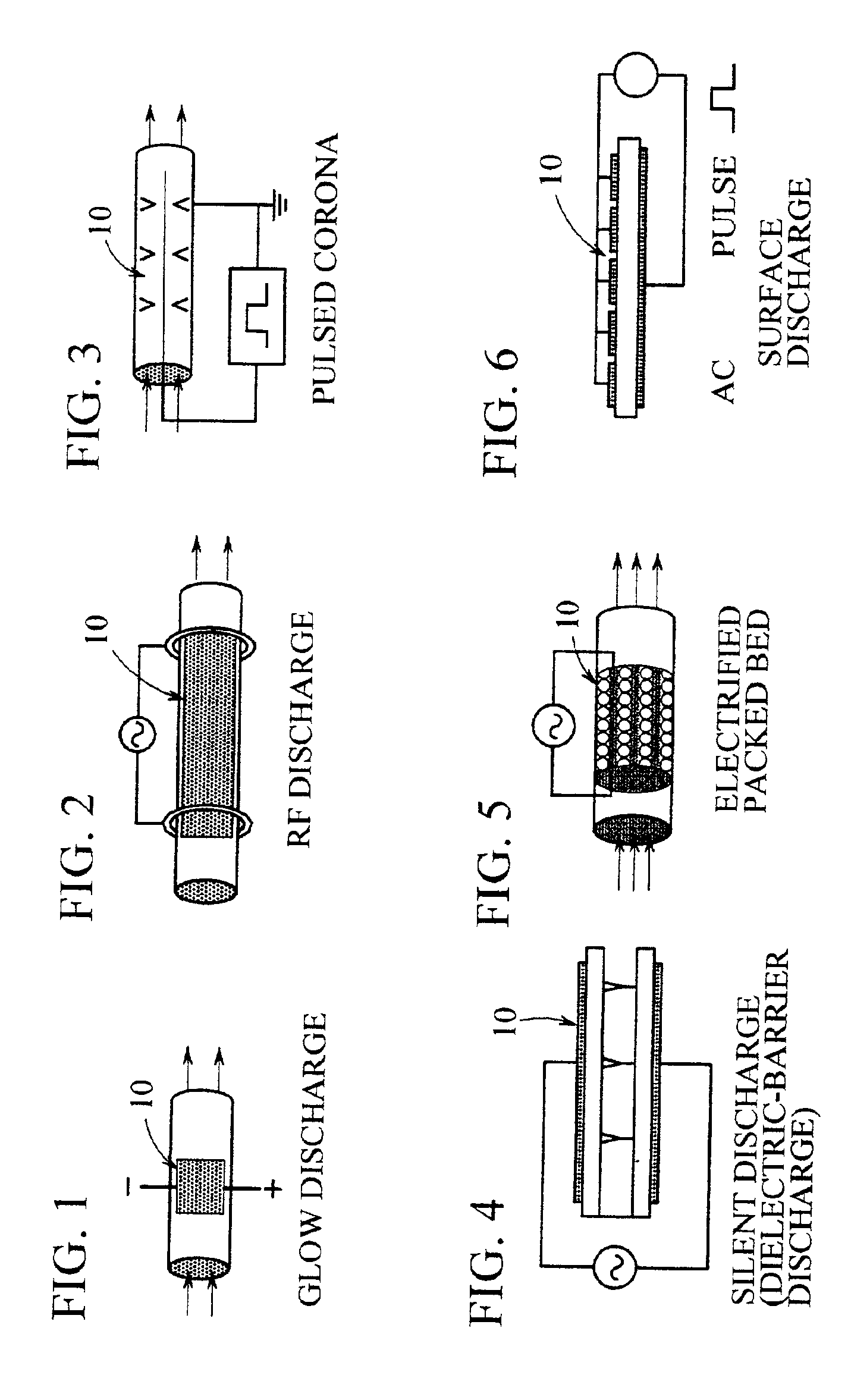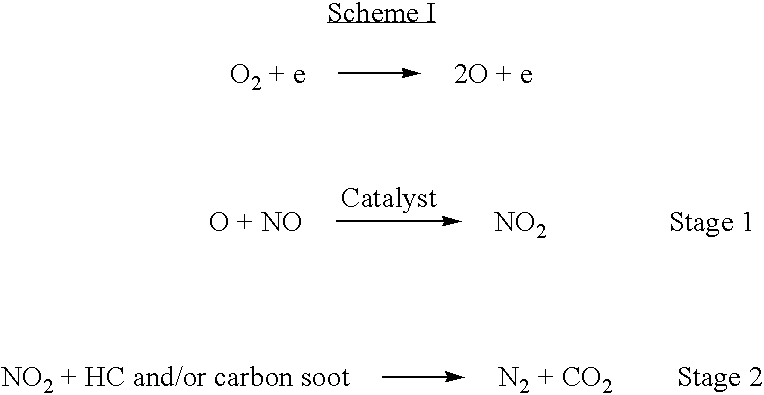Non-thermal plasma reactor gas treatment system
a plasma reactor and gas treatment technology, applied in the direction of physical/chemical process catalysts, arsenic compounds, separation processes, etc., can solve the problems of low efficiency, conventional three-way catalysts (twc) cannot adequately abate the nosub>x/sub>component, and the ozone layer is depleted
- Summary
- Abstract
- Description
- Claims
- Application Information
AI Technical Summary
Problems solved by technology
Method used
Image
Examples
example 1
81.9 grams zirconium oxynitrate and 244.7 grams of 14.0 wt % platinum ammine nitrate solution are mixed in a 2,000 milliliter (ml) beaker. 100 grams 2.0 N ammonium hydroxide is slowly dripped into the solution. 530 ml of 1 M ammonium dihydrogen phosphate is added dropwise to the solution. The resulting reaction mixture is reduced in volume to about 400 ml.
A complete non-thermal reactor is immersed into the solution. The reactor is withdrawn and calcined at 725° C. for 4 hours. The resulting product is non-thermal plasma reactor with flow passages coated with PtZr4(PO4)6.
Alternatively, about 1,000 grams of ceramic beads are immersed in the solution. The ceramic beads may be aluminum oxide, zirconium oxide, titanium oxide, and the like, as well as mixtures comprising at least one of the foregoing types of beads. The beads are withdrawn and calcined at 725° C. for 4 hours. The resulting product is non-thermal plasma reactor bed beads coated with PtZr4(PO4)6.
example 2
232 grams of 50 wt % zirconium n-propoxide in n-propanol and 244.7 grams of a 14.0 wt % platinum ammine nitrate solution are mixed in a 2,000 ml beaker. 100 grams 2.0 N ammonium hydroxide is slowly dripped into the solution. 530 ml of 1 M ammonium dihydrogen phosphate is added dropwise to the solution. The resulting reaction mixture is reduced in volume to about 400 ml.
A complete non-thermal reactor is immersed into the solution. The reactor is withdrawn and calcined at 725° C. for 4 hours. The resulting product is non-thermal plasma reactor with flow passages coated with PtZr4(PO4)6.
Alternatively, about 1,000 grams of ceramic beads are immersed in the solution. The ceramic beads may be aluminum oxide, zirconium oxide, titanium oxide, and the like, as well as mixtures comprising at least one of the foregoing types of beads. The beads are withdrawn and calcined at 725° C. for 4 hours. The resulting product is non-thermal plasma reactor bed beads coated with PtZr4(PO4)6.
example 3
81.9 grams zirconium oxynitrate and 195.5 grams of a 10.0 wt % silver ammine nitrate solution are mixed in a 2,000 ml beaker. 100 grams 2.0 N ammonium hydroxide is slowly dripped into the solution. 530 ml of 1 M ammonium dihydrogen phosphate is added dropwise to the solution. The resulting reaction mixture is reduced in volume to about 400 ml.
A complete non-thermal reactor is immersed into the solution. The reactor is withdrawn and calcined at 725° C. for 4 hours. The resulting product is non-thermal plasma reactor with flow passages coated with AgZr4(PO4)6.
Alternatively, about 1,000 grams of ceramic beads are immersed in the solution. The ceramic beads may be aluminum oxide, zirconium oxide, titanium oxide, and the like, as well as mixtures comprising at least one of the foregoing types of beads. The beads are withdrawn and calcined at 725° C. for 4 hours. The resulting product is non-thermal plasma reactor bed beads coated with AgZr4(PO4)6.
PUM
| Property | Measurement | Unit |
|---|---|---|
| Fraction | aaaaa | aaaaa |
| Fraction | aaaaa | aaaaa |
| Fraction | aaaaa | aaaaa |
Abstract
Description
Claims
Application Information
 Login to View More
Login to View More - R&D
- Intellectual Property
- Life Sciences
- Materials
- Tech Scout
- Unparalleled Data Quality
- Higher Quality Content
- 60% Fewer Hallucinations
Browse by: Latest US Patents, China's latest patents, Technical Efficacy Thesaurus, Application Domain, Technology Topic, Popular Technical Reports.
© 2025 PatSnap. All rights reserved.Legal|Privacy policy|Modern Slavery Act Transparency Statement|Sitemap|About US| Contact US: help@patsnap.com



